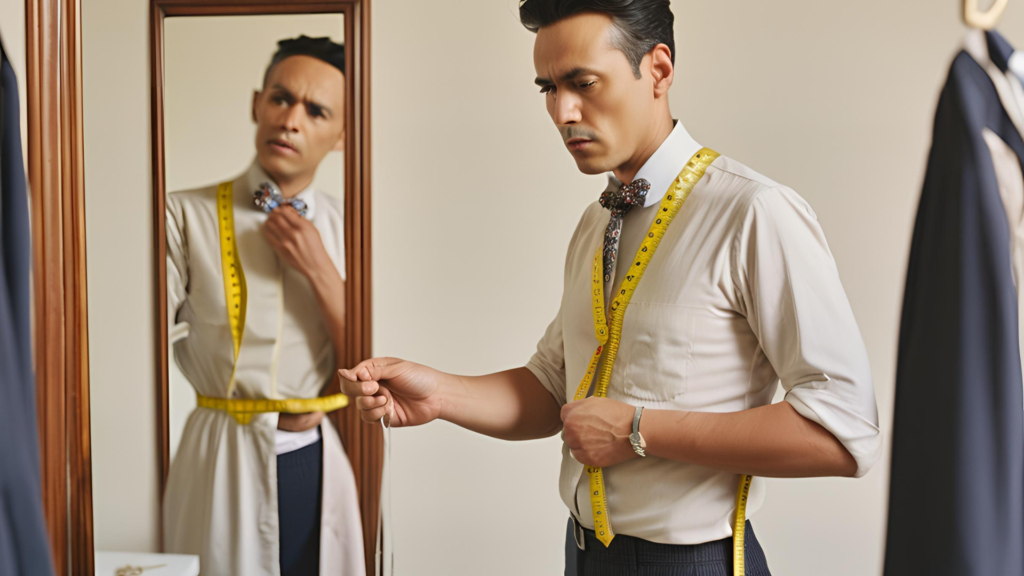Accurate Body Measurements for a Tailored Suit
A well-tailored suit can elevate your style, boost confidence, and make a lasting impression. But to achieve that perfect fit, you need accurate body measurements for a tailored suit. Whether you’re ordering a custom suit online or visiting a professional tailor, knowing your precise measurements is essential.
Every individual has a unique body shape, and off-the-rack suits rarely offer a flawless fit. This is why custom tailoring is crucial for achieving a polished and professional appearance. By understanding the right way to take accurate body measurements for a tailored suit, you eliminate guesswork and ensure your suit contours perfectly to your body. The key to a great-fitting suit is precision, and this guide will help you achieve that with ease.

In this comprehensive guide, we will break down the process of taking accurate body measurements for a tailored suit, ensuring you get a flawless fit every time. Follow these steps carefully, and you’ll never have to deal with an ill-fitting suit again.
Why Accurate Measurements Matter
A tailored suit is meant to fit like a glove. When your suit is customized to your exact body shape, it enhances your silhouette and provides unparalleled comfort. Ill-fitting suits can ruin your overall look, making you appear sloppy or uncomfortable. By taking accurate body measurements for a tailored suit, you ensure a sleek, professional appearance that exudes confidence.
Beyond aesthetics, a well-fitted suit allows for better mobility, ensuring you feel comfortable whether sitting, standing, or walking. Poorly fitted suits can restrict movement, cause discomfort, and even affect your posture. Additionally, investing in a perfectly tailored suit means you won’t have to spend extra money on alterations, making accuracy a cost-effective choice in the long run.
Whether you are dressing for business, a wedding, or a special occasion, ensuring that your suit fits well is crucial. A properly fitted suit can make you appear taller, slimmer, and more put-together, while an ill-fitting one can have the opposite effect. This is why professional tailors emphasize the importance of precise measurements—because even a fraction of an inch can make all the difference.
What You Need Before Taking Measurements
Before you start taking accurate body measurements for a tailored suit, gather the following tools:
- A flexible measuring tape: This is essential for getting precise measurements. Avoid using rigid rulers or yardsticks, as they won’t contour to your body properly.
- A mirror or a helper: Some measurements are difficult to take on your own. If possible, have someone assist you to ensure accuracy.
- A notepad or smartphone to record measurements: It’s easy to forget specific numbers, so always write them down as you go.
- A well-fitted dress shirt and trousers (for reference): Wearing form-fitting clothing can help you visualize how the final suit will look.
- Proper posture: Stand naturally and relax your muscles. Avoid slouching or puffing out your chest, as this can distort the measurements.
Taking accurate body measurements for a tailored suit in a well-lit area with ample space to move around can also help ensure precision. Avoid measuring yourself immediately after eating or exercising, as temporary fluctuations in body size can affect the readings.
Step-by-Step Guide to Taking Accurate Measurements
1. Neck Measurement
Wrap the measuring tape around your neck, just below the Adam’s apple. Ensure it is snug but not too tight. Add half an inch for comfort. The collar of your suit should not feel restrictive, allowing easy movement.
2. Shoulder Width
Measure from the edge of one shoulder to the other across the back. Keep the tape flat and straight to get an accurate body measurement for a tailored suit. The jacket’s shoulder seams should align perfectly with your shoulders without extending beyond them.
3. Chest Measurement
Stand naturally with your arms at your sides. Wrap the measuring tape around the fullest part of your chest, just under your armpits. Breathe normally to avoid a too tight or loose fit. This measurement helps ensure that the jacket sits comfortably across the torso.
4. Waist Measurement
Find your natural waistline, which is usually just above the belly button. Wrap the tape snugly around this area without compressing your stomach. This is crucial for both your suit jacket and trousers to fit properly. Having accurate body measurements for a tailored suit in this area ensures a sharp, professional appearance.
5. Hip Measurement
For pants fitting, measure around the fullest part of your hips and buttocks. This ensures the suit trousers fit properly without being too tight or loose. Be sure to keep the tape parallel to the ground for accuracy.
6. Sleeve Length
Start from the shoulder seam and measure down to your wrist. Keep your arm slightly bent to get an accurate body measurement for a tailored suit. The sleeve should end just at the wrist bone, allowing about half an inch of your dress shirt cuff to show.
7. Bicep Measurement
Flex your arm slightly and measure around the widest part of your bicep. A properly fitted suit should allow comfortable movement without excessive tightness.
8. Wrist Measurement
Wrap the tape around your wrist to ensure the suit cuffs are tailored just right. This is important for both the jacket and shirt sleeves.
9. Jacket Length
Measure from the base of your neck to the desired jacket length. Typically, the bottom of the jacket should reach the middle of your palm when your arms are at your sides. Shorter jackets create a modern look, while longer jackets offer a classic silhouette.
10. Inseam Measurement
Measure from the crotch to the bottom of the trousers. This determines the right pant length for a sharp, polished look. For a more relaxed fit, you can allow a slight break at the shoe.
11. Outseam Measurement
Start from your waist and measure down to the desired pant length. A well-fitted trouser should have minimal break at the shoe.
12. Thigh and Knee Measurement
Wrap the tape around the widest part of your thigh and knee. This ensures a comfortable fit without restricting movement, especially when sitting.

Pro Tips for Ensuring Accuracy
- Always measure twice to confirm precision.
- Use a full-length mirror to check alignment.
- Get help from a friend or tailor if possible.
- Wear minimal clothing to avoid extra bulk affecting measurements.
- Stand naturally to ensure realistic sizing.
- Take measurements at the right time of day—bodies can fluctuate slightly throughout the day, so measuring in the morning is best.
Common Mistakes to Avoid
- Pulling the tape too tight or too loose
- Measuring over bulky clothing
- Not keeping the tape level
- Ignoring posture while measuring
- Measuring too quickly—take your time to ensure accuracy.
The Role of a Tailor in Refining Fit
Even with perfect measurements, tailors perform final adjustments based on:
- Posture and body shape
- Personal style preferences
- Fabric behavior after stitching
Tailors use their expertise to refine every detail, ensuring a suit that enhances your appearance and feels comfortable. While DIY measurements are helpful, a professional tailor’s touch can make all the difference when it comes to accurate body measurements for a tailored suit.
Final Thoughts
Taking accurate body measurements for a tailored suit is essential to achieving a flawless fit. Whether you’re getting a custom suit for work, a wedding, or a special event, precision is key. Follow this guide step by step, and you’ll be well on your way to looking sharp and sophisticated.
By following these techniques and avoiding common mistakes, you ensure that your suit is perfectly tailored to your unique shape. Now that you have the knowledge, go ahead and take those measurements confidently!

[…] Use a detailed measurement guide and always double-check your figures. […]